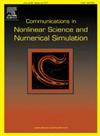复杂网络上具有非单调发病率的SIVS流行模型的动力学分析与最优控制
IF 3.8
2区 数学
Q1 MATHEMATICS, APPLIED
Communications in Nonlinear Science and Numerical Simulation
Pub Date : 2024-12-25
DOI:10.1016/j.cnsns.2024.108531
引用次数: 0
摘要
随着流行病的爆发,个体害怕被感染,变得谨慎,并采取行为改变来减少感染的可能性,特别是在高感染水平。这种现象被认为是人群中的心理效应,不仅发生在易感人群中,也发生在接种人群中。本文考虑了两个群体的心理效应,在无标度网络上构建了一个具有非单调发病率和不完全疫苗接种的SIVS新模型,该模型更接近于流行病的实际传播。在此基础上,首先推导了多个地方性平衡点的存在条件和两个阈值参数。其次,得到了在R0=1处出现后向分叉的充分必要条件。此外,还证明了无病平衡点的全局渐近稳定性和疾病的持续性。利用单调迭代技术,分析了唯一地方性平衡的全局吸引性。利用庞特里亚金极大值原理研究了最优接种策略。最后,通过数值模拟,揭示了心理效应、疫苗和疾病爆发的相互作用和影响。本文章由计算机程序翻译,如有差异,请以英文原文为准。
Dynamical analysis and optimal control of an SIVS epidemic model with nonmonotone incidence rate on complex network
With epidemic outbreak, individuals are afraid of being infected, become cautious and adopt behavioral changes to reduce their probability of being infected especially at high infective level. This phenomenon is regarded as the psychological effect in the population, which occurs not only in the susceptible population but also in the vaccinated population. In this paper, considering the psychological effects of two populations, a new SIVS model with nonmonotone incidence rate and imperfect vaccination is constructed on the scale-free network, which is more closely related to the actual spread of epidemics. Based on the model, existence conditions of multiple endemic equilibrium points and two threshold parameters are firstly derived. Next, a necessary and sufficient condition which determines the occurrence of a backward bifurcation at is obtained. Besides, the global asymptotical stability of disease-free equilibrium and the persistence of the disease are proved. By using the monotone iterative technique, the global attractivity of the unique endemic equilibrium is analyzed. And the optimal vaccinated strategy is studied by the method of Pontryagin’s maximum principle. Finally, through numerical simulations, the interaction and impact of the psychological effects, vaccines, and disease outbreaks are revealed.
求助全文
通过发布文献求助,成功后即可免费获取论文全文。
去求助
来源期刊

Communications in Nonlinear Science and Numerical Simulation
MATHEMATICS, APPLIED-MATHEMATICS, INTERDISCIPLINARY APPLICATIONS
CiteScore
6.80
自引率
7.70%
发文量
378
审稿时长
78 days
期刊介绍:
The journal publishes original research findings on experimental observation, mathematical modeling, theoretical analysis and numerical simulation, for more accurate description, better prediction or novel application, of nonlinear phenomena in science and engineering. It offers a venue for researchers to make rapid exchange of ideas and techniques in nonlinear science and complexity.
The submission of manuscripts with cross-disciplinary approaches in nonlinear science and complexity is particularly encouraged.
Topics of interest:
Nonlinear differential or delay equations, Lie group analysis and asymptotic methods, Discontinuous systems, Fractals, Fractional calculus and dynamics, Nonlinear effects in quantum mechanics, Nonlinear stochastic processes, Experimental nonlinear science, Time-series and signal analysis, Computational methods and simulations in nonlinear science and engineering, Control of dynamical systems, Synchronization, Lyapunov analysis, High-dimensional chaos and turbulence, Chaos in Hamiltonian systems, Integrable systems and solitons, Collective behavior in many-body systems, Biological physics and networks, Nonlinear mechanical systems, Complex systems and complexity.
No length limitation for contributions is set, but only concisely written manuscripts are published. Brief papers are published on the basis of Rapid Communications. Discussions of previously published papers are welcome.
 求助内容:
求助内容: 应助结果提醒方式:
应助结果提醒方式:


